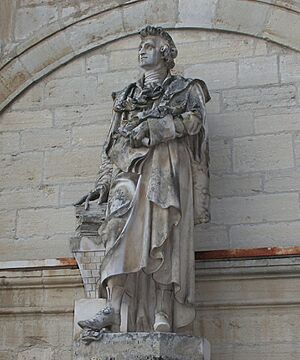Jean-Baptiste L. Romé de l'Isle facts for kids
Jean-Baptiste Louis Romé de l'Isle (born August 26, 1736 – died July 3, 1790) was a French scientist. He studied minerals and is known as one of the people who helped create modern crystallography. This is the study of how crystals are shaped and structured.
Romé de l'Isle was born in a town called Gray, Haute-Saône, in eastern France. When he was younger, he worked as a secretary for an artillery company. He traveled to the East Indies during the Carnatic Wars. In 1761, he was captured by the English and was held as a prisoner for several years. He also studied at the Collège Sainte-Barbe in Paris.
Contents
Studying Minerals and Crystals
After his time as a prisoner, Romé de l'Isle became famous for his studies. He focused on mineralogy, which is the study of minerals. He also worked on crystallography, learning about the shapes of crystals.
His Important Book
His most important book was called Cristallographie. It was published in 1783 and had three volumes, plus an atlas. This book helped explain many new ideas about crystals.
The Law of Crystal Angles
Romé de l'Isle is well-known for explaining the Law of Constancy of Interfacial Angles. This law says that the angles between the faces of a crystal are always the same for a specific type of mineral. No matter how big or small a crystal is, or where it comes from, these angles stay constant. He built on ideas first observed by another scientist named Nicolaus Steno.
Later Life and Recognition
In 1775, Romé de l'Isle was chosen as a foreign member of the Royal Swedish Academy of Sciences. This was a big honor, showing that his work was recognized internationally. He passed away in Paris, France, on July 3, 1790.
Images for kids
See also
 In Spanish: Jean-Baptiste Romé de l'Isle para niños
In Spanish: Jean-Baptiste Romé de l'Isle para niños



